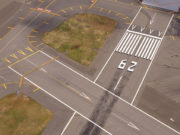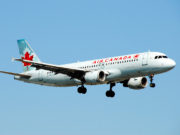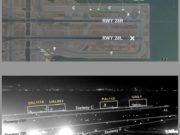Taxiway or runway confusion events often are the precursors of runway incursions and, potentially, of ground collisions between two aircraft or between an aircraft and an airport vehicle or construction equipment. Very few of the risk factors are unique. Most can be mitigated by the same safety programs that, in concert with system-level defenses and controls and best practices for flight crews, prevent runway incursions.
Defenses and controls ideally include upgrading and standardizing air carrier fleets to take full advantage of the technologies available. These include proven capabilities cited in the International Civil Aviation Organization (ICAO)–endorsed strategic action plan titled Implementing the Global Aviation Safety Roadmap, published in December 2006 as Part 2 of the Roadmap developed by the Industry Safety Strategy Group. These recommendations appear in Appendixes E, F and G, available from the ICAO Flight Safety Information Exchange Web site and from Flight Safety Foundation.
Runway or taxiway confusion events on takeoff end either in a rejected takeoff or continued takeoff, while on approach the conclusion can be either a go-around or a landing. The misused pavement can be a parallel runway, a parallel taxiway, any other active or inactive runway, or any other taxiway or closed runway.
During the takeoff phase of flight, some confusion events have resulted in a taxiway or runway incursion, sometimes with loss of separation from other aircraft. Others have caused a takeoff from a shorter-than-required runway or taxiway, reducing the safety margins designed into the accelerate-stop distance, the takeoff distance calculation and the anticipated obstacle clearance.
During approach and landing, pilot confusion has caused losses of separation or near-midair collisions as another aircraft approached the same runway or a different runway. Other outcomes have been reduced landing distance available while completing the landing on a shorter-than-required runway or taxiway, resulting in an overrun, or collisions with other aircraft or vehicles.
Recent Analysis
When 14 years of global air carrier safety data were assessed for insights into runway/taxiway confusion events, runway incursions in this period happened twice as often. In one recent five-year period, however, three times more fatalities occurred in fatal confusion accidents although they were one-third the number of fatal incursion accidents. Two caveats: Such small numbers are inconclusive, and although runway incursions worldwide typically are identified and reported accurately, taxiway or runway confusion events are a newly recognized type of event that may not be captured by today’s mandatory and voluntary reporting schemes. This is another reason that confusion events can appear to be statistically insignificant. Yet, as a precursor of harmful or deadly events, their importance should not be underestimated. My recent analysis of 100 confusion events and their regional distribution provides more evidence of the continuing and worldwide nature of this threat.
A number of these events revealed that the lack of a company airport familiarization program was a latent condition. Specifically absent were factors to increase awareness of the complex airport-movement-area layout, especially problematic intersections, ideally depicted on charts as hot spots (see “Hot Spot Intelligence”), and at least some of the standard international markings, signage, lighting and/or procedures.
Flight Dispatch
Lack of flight information or inaccurate flight information contributed to takeoff from or landing on a wrong runway, an unintended runway or a closed runway. Accidents often were avoided through the timely initiation of a rejected takeoff or a go-around. Specifically noted deficiencies were notices to airmen (NOTAMs) that had been prepared but not issued; NOTAMs that were issued but not available to flight crews from the official source; NOTAMs that mistakenly referred to a taxiway or runway that actually was not affected by the notice issued; or NOTAMs that were omitted from the flight dispatch briefing folder.
Also identified were instances in which the runway was used only occasionally for takeoffs; new taxiways or runways were under construction and not shown on the airport diagram; or current airport diagrams failed to show the actual airport configuration, signage, markings and lighting.
Flight Crew Performance
In some events studied, flight crews showed unfamiliarity with the airport due to lack of a company familiarization program and/or inadequate preflight preparation, and some crews had not reviewed relevant NOTAM(s) in the flight dispatch briefing folder. Other factors leading to a crew performance failure include a rushed cockpit atmosphere due to interruptions, distractions and/or high workload, such as receiving final weight-and-balance data or other information from the aircraft communications addressing and reporting system (ACARS) or entering last-minute data into the flight management system (FMS).
In other cases, an automatic terminal information service (ATIS) message was received but relevant information was overlooked, or a new message or special message was not read. The relevant ATIS information sometimes had been noted by the pilot monitoring — also called the pilot not flying — but either was not relayed correctly to the pilot flying or was not comprehended by the pilot flying.
An adequate taxi briefing was absent in some events, representing a failure to use all available flight deck resources such as NOTAMs, the airport diagram and charts, or other airport-specific information. In other cases, no challenge-inquiry occurred between the pilot flying and pilot monitoring, leaving unresolved doubts about aircraft position, runway in use or other facts.
Some flight crews did not seek confirmation of instructions from air traffic control (ATC) when in doubt, or an ATC instruction was accepted by the pilot monitoring but was not followed by the pilot flying. Ineffective crew communication — including failure to verbalize actions, information and clearances — sometimes involved unclear, nonstandard or incomplete phraseology that reduced the situational awareness of ATC.
Other flight crews did not adhere strictly to task sharing or to the “golden rules” of flight operations such as maintaining “one head up” — that is, one pilot’s attention focused outside the aircraft — at all times. Some aircraft were taxied without an ATC-cleared taxi route.
Lack of a readback or an incorrect readback, not challenged by the air traffic controller, resulted in confusion events and runway incursions. Some flight crews showed a bias of expectation at a familiar airport, when following the initial ATIS message, or when following a misheard ATC instruction for the assigned runway after their incorrect readback was not detected and corrected.
Changeover of function from pilot monitoring to pilot flying — especially captain to first officer just before or during lineup for takeoff — sometimes contributed to confusion because this timing required abrupt transition from head-down tasks to head-up handling duties, as well as quickly updating positional and situational awareness.
The data analysis also showed that a task-sharing scheme in which the captain functioned as pilot flying during ground operations — then made this changeover — decreased the first officer’s situational awareness at a critical phase of flight. For example, one confusion event involved early takeoff clearance at location (1) and role changeover at location (2), contributing to a takeoff from Taxiway Kilo instead of the assigned Runway 32.
One factor in several events was loss of positional awareness, basically an erroneous shift of a pilot’s “mental map,” resulting in landing at the wrong airport. Another was unawareness of a discrepancy — during descent to the wrong airport — between the actual rate of descent required and the anticipated rate of descent to the correct airport.
Sometimes the rushed approach and high crew workload led to late aircraft configuration for landing. The flight crews lacked adequate positional and energy-state awareness, although awareness-enhancing information would have been available by monitoring altitude in relation to track distance to runway threshold, observing approach sequence/timing and comparing the raw data and/or navigation display to the chart profile view of the instrument approach procedure.
Some pilots mistakenly lined up with the first visually acquired runway while turning or after turning final, while following radar vectors or a distance measuring equipment (DME) arc, or after breaking out from the overcast.
Other issues included complacency when conducting a visual approach in good weather conditions or at a familiar airport; difficulties transitioning from an instrument landing system (ILS) approach to a visual approach, causing a wrong-runway landing parallel to the assigned runway; and failure to notice the yellow “X” marking at the threshold, signifying a closed runway. Confusion also resulted when this marking was installed only at one runway end, contrary to ICAO standards.
Hypovigilance, a low alertness level caused by fatigue, and employer/personal time pressures possibly contributed to some of the confusion events.
Air Traffic Control
Several ATC-induced risk factors were noted, including these examples: A runway closure was announced in a NOTAM but not in the ATIS message; a controller issued a nonstandard taxi route to the assigned runway; a controller’s airport diagram did not show the actual airport configuration, markings, signage and lighting; a controller’s airport diagram was not consistent with the flight crew’s airport diagram; there were no airport procedures for intersection takeoffs; lack of monitoring of aircraft taxi or approach progress by the controller prevented the timely detection of pilot confusion; or a controller’s hearback or challenge was ineffective.
In some events, ATC issued the takeoff clearance without confirming the aircraft’s position, at times issuing a takeoff clearance early while the aircraft was still taxiing and had not yet reached the runway threshold or holding position marking of the intended takeoff runway, or before the aircraft had crossed all intersecting runways.
Conflicting information from approach and tower controllers about the assigned landing runway also created confusion for pilots, with controller fatigue a possible contributor.
Infrastructure Design
Airport layout or infrastructure has affected situational awareness, distracting or confusing flight crews. A common example involves airports where a single taxiway serves multiple runway thresholds. Less than optimal geometries here also increase the risk of the flight crew unintentionally taxiing onto the wrong runway, possibly one too short for takeoff. Also revealed was crew unawareness of hot spots, such as locations without taxiway/runway holding position markings to protect runway intersections. Some taxi routes crossed unassigned runways or runway thresholds before the incident aircraft reached the takeoff runway threshold or holding position.
Color contrasts — a dark-colored taxiway against a light-colored runway — also proved confusing. For example, partial snow removal caused misleading color contrast between the snow-covered active runway and a parallel taxiway that was darker and free of snow. Events also have involved ATC keeping the localizer operative on an inactive runway after switching from parallel-runway operations to single-runway operations.
Other airport-related risk factors were misleading taxiway or runway signage or markings; deteriorated markings, such as missing reflective material or rubbed-off stripes; and markings obscured by patches of snow or ice. The taxiway lighting sometimes was confusing when it was brighter than adjacent runway lighting.
Events also revealed nonstandard lighting practices, such as keeping runway centerline lighting illuminated to assist in runway inspections or searches for foreign object debris. Airports also kept approach lights to one runway illuminated to compensate for the low-intensity lighting on an active parallel runway. Some kept the visual approach slope indicator or precision approach path indicator operative alongside an inactive runway, or activated the overall runway lighting system of a closed runway while inadvertently deactivating the same system for the active runway.
Risk Management
On the positive side, runway safety teams — involving all stakeholders at airports in many countries — have encouraged aircraft operators to assess continuously the main threats, such as changes to the preferential runway system; find safe solutions to airport layout complexity and construction activity; and fix nonstandard markings, signage, lighting and ATC procedures.
Two recommended resources from the newly updated Flight Safety Foundation Approach and Landing Accident Reduction (ALAR) Tool Kit — the “Risk Awareness Tool” and the “Risk Reduction Guide” — support these types of ongoing safety assessments, encouraging airport familiarization programs and emphasizing actual event–based recurrent training.
The ALAR Tool Kit concurs that operators should assess the robustness of their dispatch information–gathering and briefing process, including the collection and dissemination of all relevant NOTAMs; compilation of flight dispatch briefing folders; completeness of the dispatcher–flight crew briefing; and updating of the FMS navigation database cycle and FMS initialization, as appropriate, with data from NOTAMs, such as inoperative navaids.
Company flight operations policies, standards and standard operating procedures (SOPs) also should include a “sterile cockpit” policy in compliance with regulations around the world, including U.S. Federal Aviation Regulations Part 121.542 or EU OPS 1.192 (h) and 1.210 (c). Guidance on embedding coping strategies in SOPs, mitigating interruptions and minimizing distractions is available in ALAR Briefing Note 2.4, “Interruptions/Distractions.” Pilot-controller communication, using standard phraseology and adhering to best practices, has been summarized in ALAR Briefing Note 2.3, “Pilot-Controller Communication.” Elements of ALAR Briefing Note 1.6, “Approach Briefing,” also are applicable to reducing risk of runway or taxiway confusion.
Many other best practices in the ALAR Tool Kit address confusion. When taxi instructions are received from ATC, for example, both pilots should refer again to the airport diagram and verbalize agreement about the assigned runway and taxi route, including any instructions to hold short of or cross an intersecting runway. The taxi and hold-short instructions should be copied as a memory aid and for reference. This practice also helps crews to be prepared to follow the clearance or instructions they actually received, not what they expected to receive.
Awareness of hot spots enables pilots to plan checks and actions to minimize workload and distractions upon arrival at these locations. If applicable, low-visibility taxi procedures and routes, and the characteristics of the airport surface movement guidance and control system, should be discussed. If any doubt exists about the taxi route and/or low-visibility taxi procedures, progressive taxi instructions should be requested.
Operator SOPs also should contain best practices to enhance situational awareness. Some European recommendations call for each pilot to have the necessary airport layout charts readily available. They also say an illuminated stop bar should never be crossed. ATC will provide explicit instructions about any alternate procedure necessitated by malfunction or other contingency. Any action that distracts the operating flight crew from taxi tasks — such as making a public address system announcement — should be avoided or made only with the parking brake set.
More best practices may be selected, as applicable, from U.S. Federal Aviation Administration (FAA) Safety Alert for Operators (SAFO) 06013, “Flight crew techniques and procedures that enhance pretakeoff and takeoff safety.” As critical steps for the lineup check, for example, this SAFO recommends confirming the intended takeoff from the runway threshold or from an intersection, as per performance calculations, and making sure of the airplane’s location at the assigned departure runway before crossing any holding position marking.
Current guidance calls for checking — during and after lineup — the aircraft heading against the assigned runway heading and the runway designation markings, if conducting the takeoff from the runway threshold, as well as the correctness of the aircraft and runway symbols on the navigation display. The aircraft symbol should be initialized at the threshold of the runway selected in the FMS flight plan. The “TO WPT” and the depiction of the standard instrument departure (Figure 3) should be located ahead of the aircraft, and the “LOC” (localizer) symbol should be centered if a localizer or ILS is available and its frequency has been selected.
Runway centerline lighting and runway edge lighting also should conform to pilot expectations for the takeoff runway, based on review of the airport diagram. The SAFO also recommends that the flight crew, after initiating the takeoff roll, verbalize the lineup check a final time by performing a challenge-response standard call such as “Active runway check. — Active runway checked.” FAA Advisory Circular 120–74A, “Flight Procedures During Taxi Operations,” and SAFO 07003, “Confirming the Takeoff Runway,” similarly emphasize the importance of coordination using all available resources.
While conducting the approach, positive visual identification of the assigned runway — particularly when landing on one of the parallel runways — requires checking internal and external cues including raw data from navaids, such as the “LOC” symbol centered if a localizer or ILS is available and the frequency has been selected. Other vital cues are the assigned runway heading; all visible runway characteristics including width, length, approach lighting and runway lighting expected; indications of traffic conflict on the ATC tower frequency; and a visual check — whenever possible — that no aircraft is holding in the takeoff position.
Michel Trémaud retired from Airbus as senior director and head of safety programs/initiatives. His career also included positions at Aerotour, Air Martinique and Bureau Veritas.



